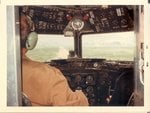What was the rationale that the propellers of P-38s rotate outwards had been a long unanswered question of my own.
If it was to make the control easier on a twin engine aircraft, the propellers should rotate inwards to bring the thrust line inwards and closer each other for the less effect of the thrust difference if one engine got troubled.
Only the reasonable explanation I got so far was that it makes the airflow over the wings stable from one of the present operator of a P-38 but was not in detail and I am not fully satisfied with that.
If it was to make the control easier on a twin engine aircraft, the propellers should rotate inwards to bring the thrust line inwards and closer each other for the less effect of the thrust difference if one engine got troubled.
Only the reasonable explanation I got so far was that it makes the airflow over the wings stable from one of the present operator of a P-38 but was not in detail and I am not fully satisfied with that.

